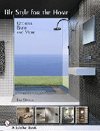
While stone and tile have been known to create a certain feel for a space, the use of innovative decorative tile products offer architects and designers the opportunity to really incorporate material that truly reflects the setting in which they are creating. Whether designing a residence to reflect the hobbies of the homeowner, or using interesting materials to capture the allure of a commercial setting, the decorative tile and mosaic options in today's market provide endless choices.
When it comes to decorative tile in the residential sector specifically, Vanessa De Leon of Vanessa De Leon Associates based in Ridgewood, NJ, is seeing a lot of three-dimensional tiles being used, especially as accent walls for bedrooms and living rooms. "Tile isn't just being used for kitchen backsplashes and bathrooms anymore; rather it is being used for more unique wall treatments lately," she said. "Three-dimensional tile is hot right now."
And while the designer continues to find that porcelain tiles are a popular request, materials such as metal -- along with the combination of glass and stone -- are also being seen more and more. "Artistic Tile has a new line out that features porcelain tile with metal inside it." she said, adding that the product is a really unique concept.
Old World Glam
When designing a New York City apartment, De Leon was challenged to use materials that would ultimately "bring the old in with the new." And, in order to meet the desired design aesthetic, a variety of decorative tiles were implemented throughout the home.
As an accent wall in the living/dining room area, pillowed decorative tile from Bisazza's Chester White collection was selected. The mosaic tile line, designed by Marco Braga, is meant to mimic 1950s buttoned upholstery, and features 10- x 10-mm mosaic pieces. "We liked the quilted effect of this tile, as it incorporates a 'glamour meets old and new' theme," said De Leon, adding that the mosaic tiles feature shades of white, cream and silver. "The silver really picks up on the accessories that are found in the space."
De Leon also carried decorative tile into the bathroom of the residence, where a brocade pattern of 17- x 26-inch porcelain tiles from Porcelanosa's Venezia Collection was selected for the wall. This specific series, known as Venis, features brocade tiles, and the color used in this bathroom is referred to as Cobre.
Furthermore, the bathroom vanity features White Carrara marble. The same material was also used as flooring in 12- x 12-inch pieces, while Venis tile in 4- x 4-inch tiles were employed as decorative inserts. The same brocade tile was also carried inside the shower where it was used as a shelf, while the shower walls and floor feature complementary mosaic tiles.
"Again, the idea here was to bring in an Old World Glamour," said the designer. "By using the White Carrara marble with the brocade effect, it gave a modern feel, with a sort of Old World glamour. It all goes back to my 'glamilistic' [streamline minimalism accented with glamorous detail] approach to design."

Tuscan Style Kitchen
Decorative tile was also implemented into the recent design of a 300-square-foot kitchen in a private residence in Southern California, where the design goal was to reflect a Tuscan style of architecture with warm elements. Jennifer Jones of Dream Maker Bath & Kitchen of Fallbrook, CA, a Division of Imagination Builders Inc., carried out the design.
"The homeowner wanted the kitchen to match the rest of her home, which had a Tuscan style to it," explained Jones, adding that another objective was to warm up the room, which was previously bland and basic. And to meet the design aesthetic, traditional stone and tile materials are complemented by a variety of decorative tile products from Gainey Ceramics Inc. of La Verne, CA. These decorative tiles were employed throughout the kitchen and bar area of the residence.
For the bar area, the designer selected a range of decorative tile elements from Gainey Ceramics. Among the products chosen were 6- x 6-inch field tiles in a shade referred to as Horizon, as well as 1- x 3-inch Grass deco tiles in a Teak shade that form the bottom border. Underneath the top row of field tile, a Hammered River Liner, also in a Teak color, was employed as a deco border around the space. Furthermore, 6- x 6-inch decorative animal imprinted tiles from Gainey's Legacy Collection were periodically inserted. Also adding visual interest is a 12- x 12-inch elephant-imprinted tile, which was used for the backsplash.
The rest of the kitchen features the same 6- x 6-inch Horizon field tiles for the backsplash, while El Dorado brick stone was used for the back wall behind the oven range. Additionally, the countertops consist of granite in a complementary hue.
"When the client saw the animals, she wanted them incorporated into the kitchen somehow," Jones said. "So, we put them in the bar area to make it fun. She liked the animals so much because her husband is a huge giraffe lover, and their backyard is pretty fun with a large cast bronze gorilla."

Feng Shui Setting
And while the use of decorative tile is on the rise in residential design, it is also being used more in the commercial arena.
Designed by TM & SK Architecture & Design of New York, Gi Fuh Loh, an authentic Cantonese restaurant at Harrah's Casino in South Lake Tahoe in Stateline, NV, features a variety of decorative stone and glass mosaics from Sicis of Italy.
One design goal, according to Taki Murao, Owner/Co-Principal of TM & SK Architecture and Design, was to take the limited space, which contained several columns and duct risers, and take advantage of them by creating interesting paths and lighting elements in the space.
"From the study of water behavior, we created narrow paths for the corridor and widened the areas for seating," Murao explained. "All elements were placed based on Feng Shui, such as a large fish tank, water cascade, copper panels, stone flooring and backlit columns." The architect went on to say that he traveled to various places in China to collect each artifact and had them air shipped to the jobsite.
One main feature of the 5,000-square-foot restaurant, which can be found on the floor of the entryway, is a 60-square-foot, circle-shaped mosaic medallion featuring a large dragon design. The medallion, which features a variety of material, including marble, Murano glass and 24-karat White Gold, was handcrafted by Sicis' mosaic artists in Italy.
The floor tile surrounding the mosaic medallion is comprised of Palais Pierre Azur. Furthermore, the reception desk tops were fabricated from slabs of Azul Bahia granite. "We needed material that could withstand the heavy commercial traffic, while also presenting a one-of-a-kind art," said Murao.
In addition to the mosaic medallion, Sicis also supplied glass mosaics for ceiling lighting pendants and illuminated columns, ceiling panels and ceiling canopies. Using Sicis' transparent Glimmer and Waterglass mosaics with a hint of opaque Murano Smalto, the ceiling pendants were artistically produced to resemble the radiance of the sun. There are also two illuminated columns in the restaurant. One was produced to resemble fire and flames, and features Neoglass Domes in gradation of color from light to dark. The other was produced in a blue rendition of a traditional Chinese character, in a gradation of color light to dark, and uses transparent blue glass mosaic colors from the Glimmer, Waterglass and Iridium series.
Moreover, ceiling panels inspired by the Ittio design from the Sicis Sheer Glass Collection, hang above the noodle bar at the restaurant, while five ceiling canopies, inspired by the Ippogriffo design from the Sicis Posh Pix Collection, hang over various portions of the restaurant. Each canopy was created with background colors from the Waterglass Collection, providing a special poetry of color from one to another, reports Sicis.
Construction of the project began in January 2007 and finished in September of 2007, and according to the architect, the reaction to the project has been amazingly positive.




